#a lot of alters speaking in this post btw. usage of i and we are interchangable unless spoken otherwise.
Explore tagged Tumblr posts
Text
also yeah hi that break did not last too long, looking at bsky too often makes me notice how active the site is while also observing how much people sincerely dont fucking care about alt text (in the "i'll add alt text but it isnt actually describing shit way) makes my blood boil lmfao.
perhaps we truly are not meant to be on fast paced sites where one must focus on business. no one wants to even be fucking friends there! its twittershit all over again!
popular artists will use you for reshare fodder! a lot of people still want to force their f4f mindsets! its like when the nth twitter exodus happened everything went to shit on bsky and i cant fucking stand it!
#kas speaks#a lot of alters speaking in this post btw. usage of i and we are interchangable unless spoken otherwise.#fucking hell people are indescribably irritating
0 notes
Text
This post is about complex dissociative disorder systems and is unlikely to be applicable to anyone else. It uses various terms (such as alter and part) in a way that best resembles the medical usage of the terms. This is not a post to debate different definitions of of these terms. This prefacing comment is simply to avoid misunderstanding due to differences in definitions.
When we speak about alters being dissociative parts, a lot of people end up treating it like it has a different defition to alter. It has a broader defintion than alter, but all alters are also dissociative parts.
Alters having individual senses of self, recall of past events, identities, and even alters who consider themselves as seperate people are still dissociative parts. All of that and more is included in the defintion of dissoociative parts.
We consider ourselves seperate people. That does invalidate the fact that we are dissociative parts, nor does us being dissociative parts invalidate that.
To be perfectly honest, we are not the most comfortable with parts language due to a lot of people viewing it as incompatibile with considering ourselves seperate people.
The best way I can provide an example of what parts language means to us is our relationship with our gender identity.
We are a transgender man. Does everyone identify as a transgender man? No. Does us all being a transgender man invalidate individual alters identities? No. Does individual alters identities mean that they are not a transgender man? Yes and no. They are not a transgender man, but we are.
I personally as an alter am a transgender man, so I am getting someone else to assist me in explaining.
-
okay hiii!!!! its mina!! :3 (it/she) (that was tim btw)
im honestly not sure what my gender is but its definitely like not a man. its feminine, or at least i talk feminine. idk. not cis, not a man. unlabel is probs best answers
anyway, im not a man, but we're a man. us being a man does not make me a man. me not being a man doesn't make us not be a man. does that make sense?
like we live our life as a man, we view the body as male, we present as a man. ive got the lived experiences of a man!
and the whole being transgender part, like im not cis, but even our alters who ID as cis are parts of a collective transgender man.
thats not saying that we, as a transgender man, have parts of us that are cisgender women. thats not how parts language works for us. we are all one man whos made up of a bunch of men, like 3 women, and some other people.
us being parts of a man is less like im the arm of a man and someone else is a leg and more like we're all stacked in an inescapable trenchcoat together.
like parts language we are honestly kinda uncomfy using just due to how people misunderstand what it means when we use it. consider ourselves seperate people and not being viewed as seperate people, as it turns out, causes us to dissociate for months on end and lose a bunch of time. fun DID things woo!!
i honestly think that like a lot of problems with how people view medical experiences is that they kinda like forget that just because somethings like a disorder doesn't change how it feels. like yeah we're dissociated parts because of trauma, but that doesnt like change the fact that we consider ourselves seperate people. like im just saying, the root of this is probably ableism and the idea that something being a medical or like pathological or disordered experience = bad wrong needs to be fixed.
anyway hope that makes sense! i actually did not bother to read most of what tim said so like if i misunderstood what he was saying and this is incoherent i am SORRY
#subsection syscourse#Mod Tim (He/Him)#mod mina (it/she)#uh we're like tagging dtuff now#idk i feel like there should be more syscourse related ones#guess not lol
1 note
·
View note
Text
Why the Clone problem in Star Wars animated media is also a Mandalorian problem, and why we have to talk about it (PART 2)
Hi! I finally finished wrapping this up, so here’s part 2 of what has already become a mini article (you can find Part 1 here, if you like!)
And for this part, it won’t be as much as a critic as part 1 was, but instead I’d like to focus more on what I consider to be a wasted potential regarding the representation of the Clones in the Star Wars animated media, from the first season of The Clone Wars till now, and why I believe it to be an extension of the Mandalorian problem I discussed in part 1 — the good old colonialism.
Sources used, as always, will be linked at the end of this post!
PART 2: THE CLONES
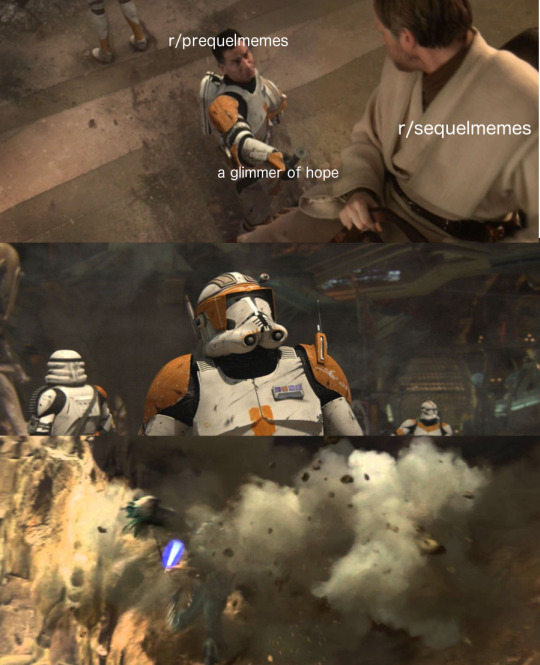
Cody will never know peace
So I’d like to state that I won’t focus as much on the blatantly whitewashing aspect, for I believe it to be very clear by now. If you aren’t familiar with it, I highly recommend you search around tumblr and the internet, there are a lot of interesting articles and posts about it that explain things very didactically and in detail. The only thing you need to know to get this started is that even at the first seasons of Clone Wars (when the troopers still had this somewhat darker skin complexion and all) they were still a whitewashed version of Temuera Morrison (Jango’s actor). And from then, as we all know, they only got whiter and whiter till we get where we are now, in rage.
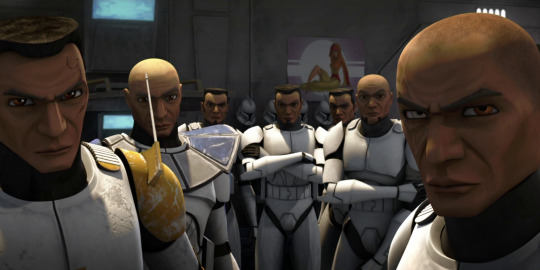
Look at this very ambiguously non-white but still westernized men fiercely guarding their pin-up space poster
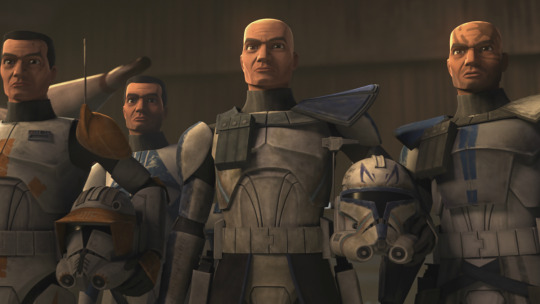
Now look at this still westernized but slightly (sarcasm) whiter men who for some reason now have different tanning levels among them (See how Rex now has a lighter skin tone? WHEN THE HELL DID THAT HAPPEN KKKKKKK) Anyway you got the idea. So without further ado...
2.1 THE FANTASY METAPHOR
As I mentioned before in Part 1, one thing that has to be very clear if you want to follow my train of thought is that it’s impossible to consume something without attributing cultural meanings to it, or without making cultural associations. This things will naturally happen and it often can improve our connection to certain narratives, especially fantastic ones. Even if a story takes place in a fantastic/sci fi universe, with all fictional species and people and worlds and cultures, they never come from nowhere, and almost always they have some or a lot of basing in real people and cultures. And when done properly, this can help making these stories resonate in a very beautifull, meaningfull way. I actually believe this intrisic cultural associations are the things that make these stories work at all. As the brilliant american speculative/science fiction author Ursula K. Le Guin says in the introduction (added in 1976) of her novel The Left Hand of Darkness, and that I was not able to chopp much because it’s absolutely genious and i’ll be leaving the link to the full text right here,
“The purpose of a thought-experiment, as the term was used by Schrodinger and other physicists, is not to predict the future — indeed Schrodinger's most famous thought-experiment goes to show that the ‘future,’ on the quantum level, cannot be predicted — but to describe reality, the present world.
Science fiction is not predictive; it is descriptive.”
[...] “Fiction writers, at least in their braver moments, do desire the truth: to know it, speak it, serve it. But they go about it in a peculiar and devious way, which consists in inventing persons, places, and events which never did and never will exist or occur, and telling about these fictions in detail and at length and with a great deal of emotion, and then when they are done writing down this pack of lies, they say, There! That's the truth!
They may use all kinds of facts to support their tissue of lies. They may describe the Marshalsea Prison, which was a real place, or the battle of Borodino, which really was fought, or the process of cloning, which really takes place in laboratories, or the deterioration of a personality, which is described in real textbooks of psychology; and so on. This weight of verifiable place-event-phenomenon-behavior makes the reader forget that he is reading a pure invention, a history that never took place anywhere but in that unlocalisable region, the author's mind. In fact, while we read a novel, we are insane —bonkers. We believe in the existence of people who aren't there, we hear their voices, we watch the battle of Borodino with them, we may even become Napoleon. Sanity returns (in most cases) when the book is closed.”
[...] “ In reading a novel, any novel, we have to know perfectly well that the whole thing is nonsense, and then, while reading, believe every word of it. Finally, when we're done with it, we may find — if it's a good novel — that we're a bit different from what we were before we read it, that we have been changed a little, as if by having met a new face, crossed a street we never crossed before. But it's very hard to say just what we learned, how we were changed.
The artist deals with what cannot be said in words.
The artist whose medium is fiction does this within words. The novelist says in words what cannot be said in words. Words can be used thus paradoxically because they have, along with a semiotic usage, a symbolic or metaphoric usage. [...] All fiction is metaphor. Science fiction is metaphor. What sets it apart from older forms of fiction seems to be its use of new metaphors, drawn from certain great dominants of our contemporary life — science, all the sciences, and technology, and the relativistic and the historical outlook, among them. Space travel is one of these metaphors; so is an alternative society, an alternative biology; the future is another. The future, in fiction, is a metaphor.
A metaphor for what?” [1]
A metaphor for what indeed. I won’t be going into what Star Wars as a whole is a metaphor for, because I am certain that it varies from person to person, and everyone can and has the total right to take whatever they want from this story, and understand it as they see fit. That’s why it’s called the modern myth. And therefore, all I’ll be saying here is playinly my take not only on what I understand the Clones to be, but what I believe they could have meant.
2.2 SO, BOBA IS A CLONE
I don’t want to get too repetitive, but I wanted to adress it because even though I by no means intend to put Boba and the Clones in the same bag, there is one aspect about them that I find very similar and interesting, that is the persue of individuality. While the Clones have this very intrinsically connected to their narratives, in Boba’s case this appears more in his concept design. As I mentioned in Part 1, one of the things the CW staff had in mind while designing the mandalorians is that they wanted to make Boba seem unique and distinguishable from them, and honestly even in the original trilogy he stands out a lot. He is unique and memorable and that’s one of the things that draws us to him.
And as we all know, both Boba and Jango and the Clones are played by Temuera Morrison — and occasionally by the wonderful Bodie Taylor and Daniel Logan. And Temuera Morrison comes from the Maori people. And differently from the mandalorian case, where we were talking about a whole planet, in this situation we’re talking about portraying one single person, so there’s nowhere to go around his appearance and phenotypes, right? I mean, you are literally representing an actual individual, so there’s no way you could alter their looks, right?
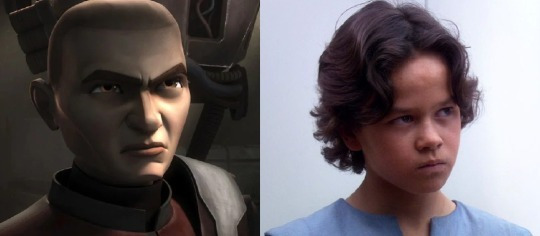
(hahahaha wrong)
And besides that, I think that is in situations like that (when we are talking about individuals) that the actor’s perspective could really have a place to shine (just the same as how Lea was mostly written by Carrie Fisher). In this very heart-warming interview for The New York Times (which you can read full signing up for their 5-free-articles-per-month policy), Temuera Morrison talks a little bit about how he incorporated his cultural background to Boba Fett in The Mandalorian:
“I come from the Maori nation of New Zealand, the Indigenous people — we’re the Down Under Polynesians — and I wanted to bring that kind of spirit and energy, which we call wairua. I’ve been trained in my cultural dance, which we call the haka. I’ve also been trained in some of our weapons, so that’s how I was able to manipulate some of the weapons in my fight scenes and work with the gaffi stick, which my character has.” [2]
The Gaffi stick (or Gaderffii), btw, is the weapon used by the Tusken Raiders on Tatooine, and according to oceanic art expert Bruno Claessens it’s design was inspired by wooden Fijian war clubs called totokia. [3]
And I think is very clear how this background can influence one’s performance and approach to a character, and majorly how much more alive this character will feel like. Beyond that, having an actor from your culture to play and add elements to a character will higly improve your sense of connection with them (besides all the impact of seeying yourself on screen, and seeying yourself portrayed with respect). It would only make sense if the cultural elements that the actor brought when giving life to a fictional individual would’ve been kept and even deepened while expanding this role. And if you’re familiar with Star Wars Legends you’ll probably rememeber that in Legends Jango would train and raise all Clone troopers in the Mandalorian culture, so that the Clones would sing traditional war chants before battles, be fluent in Mando’a (Mandalore’s language) and some would proudly take mandalorian names for themselves. So why didn’t Filoni Inc. take that into account when they went to delve into the clones in The Clone Wars?
2.3 THE WHITE MINORITY
First of all I’d like to state that all this is 100% me conjecturing, and by no means at all I’m saying that this is what really happened. But while I was re-watching CW before The Bad Batch premiere, something came to my mind regarding the whitewashing of the Clones, and I’d like to leave that on the table.
So, you know this kind of recent movies and series that depicted like, fairies in this fictional world where fairies were very opressed, but there would be a lot of fairies played by white actors? Just like Bright and Carnival Row. If you’ve watched some of these and have some racial conscience, you’ll probably know where I’m going here. And the issue with it is that often this medias will portray real situations of racism and opression and prejudice, but all applied to white people. Like in Carnival Row, when going to work as a maid in a rich human house, our girl Cara Delevingne had to fight not to have her braids (which held a lot of significance in her culture) cut by her intolerant human mistress, because the braids were not “appropriate”. Got it? hahahaha what a joy

Look at her ethnic braids!!!
One of the reasons this happens might be to relieve a white audience of the burden of watching these stories and feeling what I like to call “white guilt”. Because, as we all know, white people were never very oppressed. Historically speaking, white people have always been in privileged social positions, and in an exploitative relationship between two ethnic groups, white people very usually would be the exploiters — the opressors. So while watching situations (that every minority would know to be very real) of opression in fiction, if these situations were lived by a white actor, there would be no real-life associations, because we have no historical parameter to associate this situation with anything in real life — if you are white. Thus, there is less chance that, when consuming one of these narratives, whoever is watching will question the "truthfulness" of these situations (because it's not "real racism", see, "they're just fairies"). It's easier for a person to watch without having to step out of their comfort zone, or confront the reality of real people who actually go through things like that. There's even a chance that this might diminish empathy for these people.
Once again, not saying this is specifically the case of the Clones, majorly because one of the main feelings you have when watching CW is exactly empathy for the troopers (at least for me, honestly, the galaxy could explode, I just wanted those poor men to be happy for God’s sake). But I’ll talk more about it later.
The thing is, the whole thing with the Clones, if you think about it, it’s not pretty. If you step on little tiny bit outside the bubble of “fictional fantasy”, the concept is very outrageous. They are kept in conditions analogous to slavery, to say the least. To say the more, they were literally made in an on-demand lab to serve a purpose they are personally not a part of, for which they will neither receive any reward nor share any part of the gains. On the contrary, as we saw in The Bad Batch, as soon as the war was over and the clones were no longer useful as cannonballs, they were discarded. In the (wonderful) episode 6 of the third season of (the almost flawless) Rebels, “The Last Battle”, we're even personally introduced to the analogy that there really wasn't much difference in value between clones and droids, something that was pretty clear in Clone Wars but hadn't been said explicitly yet.
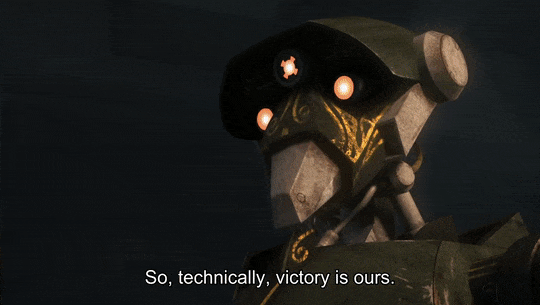
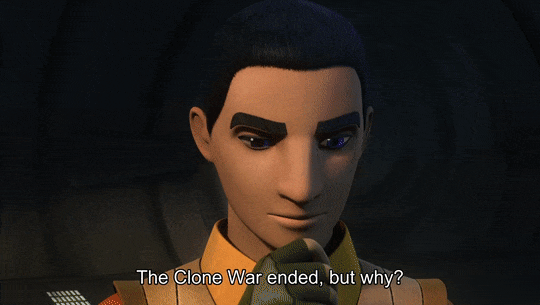
In fact, technically the Separatists can be considered to be more human than the Republic. But that's just my opinion.
So, you had this whole army of pretty much slaves. I know this is a heavy term, but these were people who were originally stripped of any sense of humanity or individuality, made literally to go to war and die in it, doing so purely in exchange for food and lodging, under the false pretense that they belonged to a glorious purpose (yes, Loki me taught that term, that was the only thing I absorbed from this series). Doing all this under extremely precarious conditions from which they had no chance of getting out, actually, getting out was tantamount to the death penalty. They were slaves. In milder terms, an oppressed minority. And again, I don't know if that was the case, but I can understand why Filoni Inc would be apprehensive about representing phenotically indigenous people in this situation. Especially since we in theory should see Anakin and Obi-Wan as the good guys.
(and here I’d like to leave a little disclaimer that I believe the whole Anakin-was-a-slave-once plot was HUGELY misused (and honestly just badly done) both in the prequels and in the animeted series — maybe for the best, since he was, you know, white and all that, and I don’t know how the writers would have handled it, but ANYWAY — I believe this could have been further explored, particularly regarding his relationship with the Clones, and how it could have influenced his revolt against the Jedi, and manipulated to add to his anger and all that. I mean, we already HAD the fact that Anakin shared a deeper conection with his troopers than usual)
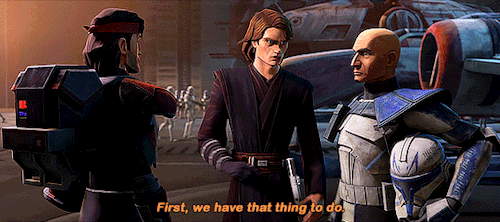

Yes, Rex, you have common trauma experiences to share. But anyway, backing to my track
As I was saying, we are to see them as good guys, and maybe that could’ve been tricky if we saw them hooping up on slavery practices. Like, idk, a “nice” sugar plantation owner? (I don’t know the correct word for it in english, but in portuguese they were called senhores de engenho) Like this guy from 12 Years a Slave?
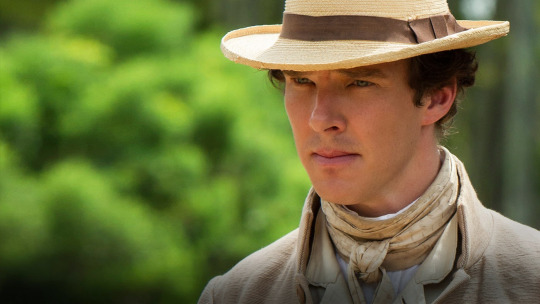
You know, the slave owner who was “nice”. IDK, anyway
No one will ever watch Clone Wars and make this association (I believe not, at least), of course not. But if we were to see how CW deepened the clone arcs, and see them as phenotypically indigenous, subjected to certain situations that occur in CW (yes, like Umbara), maybe some kind of association would’ve been easier to make.
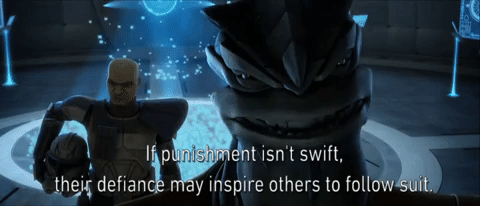
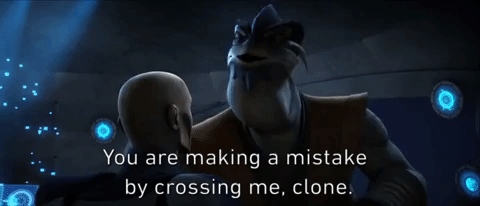
I mean, come onnnn I can’t be the only one seeing it
You see, maybe not the whole 12 Years a Slave association one, but I don’t think it’s hard to see there was something there. And maybe this could’ve been even more evident if they looked non-white. Because historically, both black peoples and indigenous peoples went through processes of slavery, from which we as a society are still impacted today. And to slave a people, the first thing you have to do is strip them from their humanity. So it might be easier to see this situation and apply it to real life. And maybe that could lead to a whole lot of other questions regarding the Clones, the Republic, the Jedi, and even how chill Obi-Wan was about all this. We might come out of it, as lady Ursula Le Guin stated in the fragment above, a bit different from what we were before we watch it.
Maybe even unconsciously, Filoni Inc thought we would be more confortable watching if they just looked white (and because of colonialism and all that, but I’m adding thoughts here).
And of course I don’t like the idea of, idk, looking at Obi-Wan and thinking about Benedict Cumberbatch in 12 Years a Slave or something like that. Of course that, if the Clones were to play the same role as they did in the prequels, to obediently serve the Jedi and quietly die for them, that would have been bad, and hurtfull, and pejorative if added to all that I said here. But the thing is that Clone Wars, consciously or not, already solved that. At least to my point of view, they already managed to approach this situation in an incredible competent way, that is giving them agency.
2.4 AGENCY AND INDIVIDUALITY
So, one of the things I love most in Clone Wars is how it really feels like it’s about the Clones. Like, we have the bigger scene of Palpatine taking over, Ahsoka’s growth arc, Anakin’s turn to The Dark Side, the dawn of the Jedi and rise of the Empire and all that, but it also has this idk, vibe, of there’s actually something going on that no one in scene is talking about? And this something is the Clones. We have these episodes spread throughout the seasons, even out of chronological order, which when watched together tell a parallel story to the war, to everything I mentioned. Which is a story about individuals. Clone Wars manages to, in a (at least to me) very touching way, make the Clones be the heros.

Can you really look me in the eye and say that Five’s story didn’t CRASH you like a full-speed train???? He may not have the same amount of screen-time as the protagonists, but his story is just as important as theirs (and to me, it might be the most meaningful one). Because he is the first to break free from the opression cicle all the Clones were trapped into.

His story can be divided into 6 phases.
1 - First, the construction of his individuality, in other words, the reclaiming of his humanity.
2 - Then the assimilation of understanding yourself as an individual of value, and then extending this to all his brothers, not as a unit, but as a set of individuals collectively having this same newly discovered value.
3 - This makes him realize that in the situation they find themselves in, they are not being recognized as such. This makes him question the reality of their situation.
4 - Freed from the illusion of his state, he seeks the truth about it.
5 - This then leads him to seek liberation not just for himself, but for all the Clones (it's basically Plato's Cave, and I'm not exaggerating here).
6 - And finally, precisely because he has assimilated his individuality and sought freedom for himself and his brothers, he is punished for it.
His story is all about agency. Agency, according to the Wikipedia page that is the first to appear if you type “agency” on Google, is that agency is “the abstract principle that autonomous beings, agents, are capable of acting by themselves” [4], and this abstract principle can be dissected in 7 segments:
Law - a person acting on behalf of another person
Religious - "the privilege of choice... introduced by God"
Moral - capacity for making moral judgments
Philosophical - the capacity of an autonomous agent to act, relating to action theory in philosophy
Psychological - the ability to recognize or attribute agency in humans and non-human animals
Sociological - the ability of social actors to make independent choices, relating to action theory in sociology
Structural - ability of an individual to organize future situations and resource distribution
All of them apply here. And this is just the story of one Clone. We know there are many others throughout the series.
Agency is what can make the world of a difference when you are telling a story about an opressed minority. Because opressed minorities do exist, and opression exists, and if you are insecure about consuming a fictional media about opressed minorities, see if they have agency might be a good place to start. So that’s why I think that everything I said before in 2.3 falls short. Because the solution already existed, and was indeed done. Honestly, making the non-agency representation of the Clones (the one we see in the prequels) to be the one played by Temuera Morrison, and then giving them agency in the version where they appear to be white, just leaves a bitter taste in my mouth.
And honestly, if they were to make the Clones look like Temuera Morrison, and by that mean, take more inspiration in the Māori culture, maybe they wouldn’t even have to change much of their representation besides their facial features. As I said in part 1, I am not by any means an expert in polynesian cultures, but there was something that really got me while I was researching about it. And is the facial tattoos. More precisely, the tā moko.
2.5 TĀ MOKO
Once again I’ll be using the Te Ara: The Encyclopedia of New Zealand as source, and you can find the articles used linked at the end of this post.
Etymologically speaking,
“The term moko traditionally applied to male facial tattooing, while kauae referred to moko on the chins of women. There were other specific terms for tattooing on other parts of the body. Eventually ‘moko’ came to be used for Māori tattooing in general.” [5]
So moko is the correct name for the characteristic tattoos we often see when we look for Māori culture.
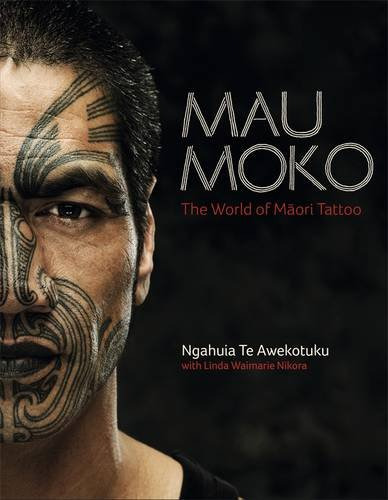
These ones ^. Please also look this book up, it’s beautiful. It’s written by Ngahuia Te Awekotuku, a New Zealand academic specialising in Māori cultural issues and a lesbian activist. She’s wonderful.
According to the Tourism NewZealand website,
“In Māori culture, it [moko] reflects the individual's whakapapa (ancestry) and personal history. In earlier times it was an important signifier of social rank, knowledge, skill and eligibility to marry.”
“Traditionally men received moko on their faces, buttocks and thighs. Māori face tattoos are the ultimate expression of Māori identity. Māori believe the head is the most sacred part of the body, so facial tattoos have special significance.”
[...] “The main lines in a Māori tattoo are called manawa, which is the Māori word for heart.” [6]
Therefore, in the Māori culture, there’s this incredibly deep meaning attributed to the (specific of their culture) tattooing of the face. The act of tattooing the body, any part of the body, is incredibly powerful in many cultures around the globe. The adornment of the body can have different meanings for these different cultures, but all of which I've come into contact with do mean a lot. It’s one of the oldest and most beautiful human expressions of individuality and identity.
And in the Star Wars universe, the Clones are the group that has the deeper connection to, and the best narrative regarding, tattoos. In fact, besides Hera’s father, Cham Syndulla, the Clones are the only individuals to have tattooed skin, at least that I can recall of. And they do share a deep connection to it.
For the Clones, the tattoos (added to hairstyles) are the most meaningful way in which they can express themselves. Is what makes them distinguishable from each other to other people. Tattoos are one of the things that represent them as individuals.
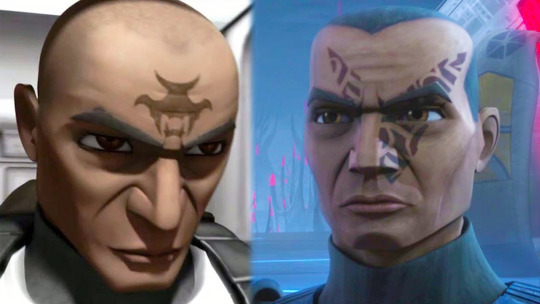
And I’m not BY ANY MEANS sayin that the Clones facial tattoos = Moko. That’s not my point. But that’s one of the things I meant when I said earlier about the wasted potential of the representation of the Clones (in my point of view). Because maybe if it were their intention to base the culture of the clones after the polynesian culture, maybe if it were their intention to make the Clones actually look like Temuera Morrison, this could have meant a whole deal. More than it’d appear looking to it from outside this culture. Maybe if there were actual polynesian people in the team that designed the Clones and wrote them (or at least indigenous people, something), who knows what we could’ve had.
Even in Hunter’s design, I noticed that if you take for example this frame of Temuera from the movie River Queen (2005), where we can have a closer look at the design of his tā moko
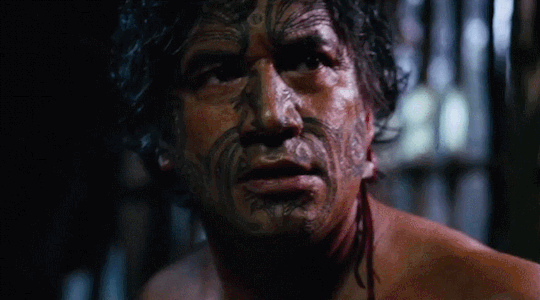
Speaking purely plastically (because I don’t want to get into the movie itself, just using it as example because then I can use Temuera himself as a comparison), see the lines around the contours of his mouth? Now look at Hunter’s.

I find it interesting that they choose to design this lines coming from around his nose like that. But at this point I am stretching A LOT into plastic and semiotics, so this comparison is just a little thing that got my attention. I know that his tattoo is a skull and etc etc, I’m just poiting this out. And it even makes me a little frustrated, because they could have taken so many interesting paths in the Bad Batch designs. But instead they choose to pay homage to Rambo. And I mean, I like Rambo, I think he’s cool and all that.
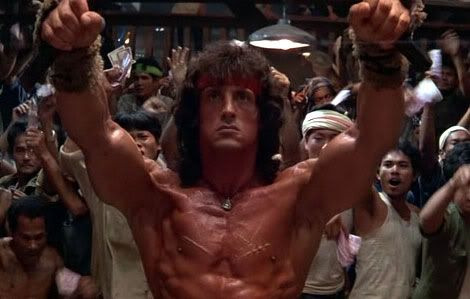
Look at him doing Filipino martial arts
But then, as we say in Brasil, they had the knife and the cheese in their hands (all they had to do was cut the cheese, but they didn’t). Istead, it seems like in order to make Hunter look like Rambo, they made him even whiter???
2.6 SO...
Look, I love The Clone Wars. I’m crazy about it. I love the Clones, I love their stories and plots. They are great characters and one of the greatest addings ever made in the Star Wars universe. They even have, in my opinion, the best soundtrack piece to feature in a Star Wars media since John Williams’ wonderful score. It just feels to me as if their narrative core is full of bagage, and meanings, and associations that were just wiped under the carpet when they suddenly became white. It just feels to me as if, once again, they were trying to erase the person behing the trooper mask, and the people they were to represent, and the history they should evoke.
I don’t know why they were whitewashed. Maybe it was just the old due racism and colonialism. Maybe it was meant for us to not question the Jedi, or our good guys, or the real morality of this fictional universe where we were immersed. But then, was it meant for what?
The Clones were a metaphor for what?

(spoiler: the answer still contains colonialism)
Thank you so much for reading !!!! (and congratulations for getting this far, you are a true hero)
SOURCES USED IN THIS:
[1] Ursulla K. Le Guin, 'The Left Hand of Darkness', 14th ACE print run of June, 1977
[2] Dave Itzkoff, 'Being Boba Fett: Temuera Morrison Discusses ‘The Mandalorian’', The New York Times, published Dec. 7, 2020, https://www.nytimes.com/2020/12/07/arts/television/the-mandalorian-boba-fett-temuera-morrison.html (accessed 15 September 2021)
[3] Bruno Claessens, 'George Lucas' "Star Wars" and Oceanic art' , Archived from the original on December 5, 2020, https://web.archive.org/web/20201205114353/http://brunoclaessens.com/2015/07/george-lucas-star-wars-and-oceanic-art/#.YEiJ-p37RhF (accessed 15 September 2021)
[4] Wikipedia contributors, "Agency," Wikipedia, The Free Encyclopedia, https://en.wikipedia.org/w/index.php?title=Agency&oldid=1037924611 (accessed September 17, 2021)
[5] Rawinia Higgins, 'Tā moko – Māori tattooing - Origins of tā moko', Te Ara - the Encyclopedia of New Zealand, http://www.TeAra.govt.nz/en/ta-moko-maori-tattooing/page-1 (accessed 17 September 2021)
[6] Tourism New Zealand, ‘The meaning of tā moko, traditional Māori tattoos’, The Tourism New Zealand website, https://www.newzealand.com/us/feature/ta-moko-maori-tattoo/ (accessed 17 September 2021)
#THE CLONES DESERVED BETTER WE ALL KNOW IT#star wars#star wars animated series#the bad batch#clone troopers#tbb#mandalorian#colonialism#whitewashing#UnwhitewashTBB#semiotics#visual culture#cw#the clone wars#star wars the clone wars#rex#hunter#the bad batch hunter#dave filoni#temuera morrison#maori culture#moko#anakin skywalker#star wars rebels#obi wan#capitan rex#cody
27 notes
·
View notes